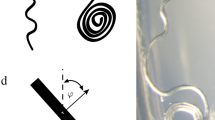Abstract
STUDIES of root systems have in the past been accomplished by various methods of excavation in situ or by the growing of plants in specially constructed boxes which can be dismantled to allow removal of the soil. It is impossible to conduct developmental studies by this means unless a number of subjects are examined at various stages of their growth, and in any event the process is extremely laborious. In work on fruit trees at East Malling, Rogers1 has designed observation trenches which are in the form of a walled chamber fitted with plate-glass windows. This gives a view of root lets impinging against the glass.
This is a preview of subscription content, access via your institution
Access options
Subscribe to this journal
Receive 51 print issues and online access
$199.00 per year
only $3.90 per issue
Buy this article
- Purchase on Springer Link
- Instant access to full article PDF
Prices may be subject to local taxes which are calculated during checkout
Similar content being viewed by others
References
East Malling Research Station. Annual Report (21st Year) 1933, pp. 86–91.
Author information
Authors and Affiliations
Rights and permissions
About this article
Cite this article
BATES, G. A Device for the Observation of Root Growth in the Soil. Nature 139, 966–967 (1937). https://doi.org/10.1038/139966b0
Published:
Issue Date:
DOI: https://doi.org/10.1038/139966b0
This article is cited by
-
Installation and imaging of thousands of minirhizotrons to phenotype root systems of field-grown plants
Plant Methods (2022)
-
Root identification in minirhizotron imagery with multiple instance learning
Machine Vision and Applications (2020)
-
Root phenotypic detection of different vigorous maize seeds based on Progressive Corrosion Joining algorithm of image
Plant Methods (2019)
-
Adaptive minirhizotron for pepper roots observation and its installation based on root system architecture traits
Plant Methods (2019)
-
An evaluation of inexpensive methods for root image acquisition when using rhizotrons
Plant Methods (2017)
Comments
By submitting a comment you agree to abide by our Terms and Community Guidelines. If you find something abusive or that does not comply with our terms or guidelines please flag it as inappropriate.



